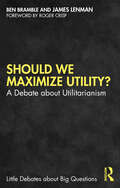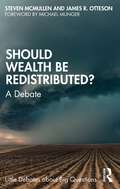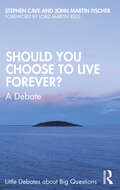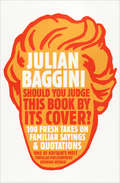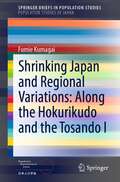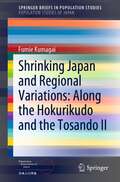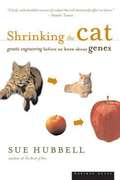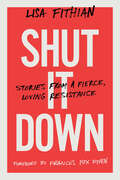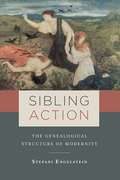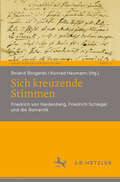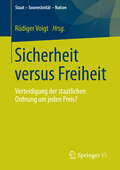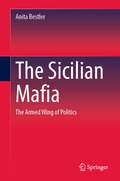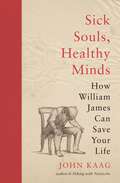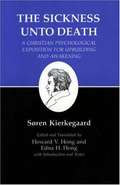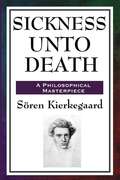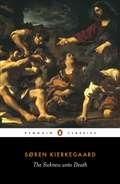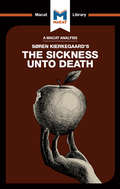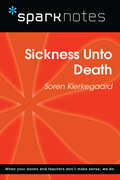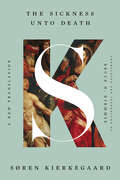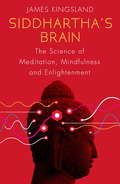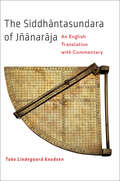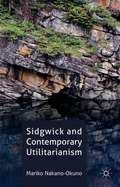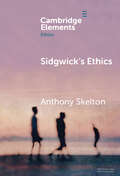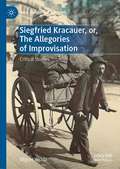- Table View
- List View
Should We Maximize Utility?: A Debate about Utilitarianism (Little Debates about Big Questions)
by null Ben Bramble null James LenmanUtilitarianism directs us to act in ways that impartially maximize welfare or utility or at least aim to do that. Some find this view highly compelling. Others object that it has intuitively repugnant results, that it condones evildoing and injustice, that it is excessively imposing and controlling, that it is alienating, and that it fails to offer meaningful, practical guidance.In this ‘Little Debates’ volume, James Lenman argues that utilitarianism’s directive to improve the whole universe on a cosmic time scale is apt to lead it down a path of imperious moral overreach. The project, he further maintains, ultimately shipwrecks on an extreme lack of epistemic humility in framing the determinants of what is morally right and wrong beyond the limits of what we can ever hope to know. Utilitarianism thus leaves us morally clueless. In contrast, Ben Bramble seeks to develop and defend an original form of utilitarianism, less vulnerable than other, more familiar versions to a number of important objections, including those raised by Lenman. He aims to avoid such unappealing results by presenting it as a claim about what we have the most reason to do, and not as a theory of right action, which Bramble urges we should understand quite differently by reference to what would motivate virtuous people.Key Features: Focuses on one of the dominant ethical theories debated by moral philosophers today Clearly written, free of jargon and technicality, and highly accessible to students Addresses questions of great importance to anyone wishing to grow in understanding of human moral life Provides a glossary of key terms highlighted in bold as well as a bibliography for further reading Important issues discussed include: welfare; value; right action; virtue; impartiality; obligations to non-human animals; the badness of human extinction; the happiness of future people; the ethics of climate change; the long term future; and the moral significance of the limits to what we can know.
Should Wealth Be Redistributed?: A Debate (Little Debates about Big Questions)
by Steven McMullen James R. OttesonA central contested issue in contemporary economics and political philosophy is whether governments should redistribute wealth. In this book, a philosopher and an economist debate this question. James Otteson argues that respect for individual persons requires that the government should usually not alter the results of free exchanges, and so redistribution is usually wrong. Steven McMullen argues that governments should substantially redistribute wealth in order to ensure that all have a minimal opportunity to participate in economic life. Over the course of the exchange, the authors investigate a number of important questions. Is redistribution properly a question of justice, and what is the appropriate standard? Has the welfare state been effective at fighting poverty? Can we expect government intervention in the economy to be helpful or counterproductive? Are our obligations to help the poor best met through government action, or through private philanthropy and individual charity? The book features clear statements of each argument, responses to counterarguments, in-text definitions, a glossary of key terms, and section summaries. Scholars and students alike will find it easy to follow the debate and learn the key concepts from philosophy, politics, and economics necessary to understand each position. Key Features: Offers clear arguments written to be accessible to readers and students without a deep background in economics, philosophy, or political theory. Fosters a deep exchange of ideas with responses from each author to the main arguments. Provides in-text definitions and a glossary with definitions of key terms. Includes section summaries that give an overview of the main arguments and a comprehensive bibliography for further reading.
Should You Choose to Live Forever?: A Debate (Little Debates about Big Questions)
by Stephen Cave John Martin FischerIn this book, Stephen Cave and John Martin Fischer debate whether or not we should choose to live forever. This ancient question is as topical as ever: while billions of people believe they will live forever in an otherworldly realm, billions of dollars are currently being poured into anti-ageing research in the hope that we will be able to radically extend our lives on earth. But are we wise to wish for immortality? What would it mean for each of us as individuals, for society, and for the planet? In this lively and accessible debate, the authors introduce the main arguments for and against living forever, along with some new ones. They draw on examples from myth and literature as well as new thought experiments in order to bring the arguments to life. Cave contends that the aspiring immortalist is stuck on the horns of a series of dilemmas, such as boredom and meaninglessness, or overpopulation and social injustice. Fischer argues that there is a vision of radically longer lives that is both recognizably human and desirable. This book offers both students and experienced philosophers a provocative new guide to a topic of perennial importance. Key Features: Gives a comprehensive overview of the main arguments for and against living forever. Uses lively examples from myth, literature, and novel thought experiments. Highly accessible—avoiding jargon and assuming no prior knowledge—without sacrificing intellectual rigour. Includes helpful pedagogical features, including chapter summaries, an annotated reading list, a glossary, and clear examples.
Should You Judge This Book By Its Cover?: 100 Fresh Takes On Familiar Sayings And Quotations
by Julian BagginiA philosopher takes a second look at sayings, proverbs, and bits of homespun wisdom: &“Every society needs its guardian of good sense: Baggini is ours.&” —The Financial Times These short, stimulating, and entertaining capsules of philosophy delve into the familiar words that live in our consciousness yet are rarely examined. Should you really do as the Romans do when in Rome and practice what you preach? Is the grass always in fact greener on the other side of the fence, and is there ever smoke without fire? Is beauty always in the eye of the beholder and is it actually better to be safe than sorry? From the popular author of The Pig That Wants to Be Eaten, cofounder of The Philosophers&’ Magazine, and academic director of the Royal Institute of Philosophy, this is a witty, deeply thought-provoking reminder that we should never stop asking questions.
Showing Time: In Memory of Alberto Argenton
by Ian F. Verstegen Laura Messina-Argenton Tiziano Agostini Tamara PrestHow does a visual artist manage to narrate a story, which has a sequential and therefore temporal progression, using a static medium consisting solely of spatial sign elements and, what is more, in a single image? This is the question on which this work is based, posed by its designer, Alberto Argenton, to whose memory it is dedicated. The first explanation usually given by scholars in the field is that the artist solves the problem by depicting the same character in a number of scenes, thus giving indirect evidence of events taking place at different times. This book shows that artists, in addition to the repetition of characters, devise other spatial perceptual-representational strategies for organising the episodes that constitute a story and, therefore, showing time. Resorting to the psychology of art of a Gestalt matrix, the book offers ha formattato: Italiano (Italia) Codice campo modificato ha formattato: Italiano (Italia) ha formattato: Italiano (Italia) researchers, graduates, advanced undergraduates, and professionals a description of a large continuous pictorial narrative repertoire (1000 works) and an in-depth analysis of the perceptual-representational strategies employed by artists from the 6th to the 17th century in a group of 100 works narrating the story of Adam and Eve.
Shrinking Japan and Regional Variations: Along the Hokurikudo and the Tosando I (SpringerBriefs in Population Studies)
by Fumie KumagaiThis book provides an insightful sociological study of the shrinking Japanese population through a regional variation perspective as it varies significantly by municipality, even within the same prefecture. Using demographic data on municipal levels, the book identifies the power unique to each municipality, which can mobilize a shrinking but sustainable Japan. The study identifies the principal explanatory factors based on the small area data of e-Stat through GPS statistical software tools such as G-census and EvaCva within a historical perspective. The theoretical framework of this study, i.e., the reason for regional variations in Japan, is the Goki-Shichido (Five Home Provinces and Seven Circuits of Ancient Japan). This historical knowledge helps in understanding the significance of the regional cultural heritage that remains in each municipality today. The book pays special attention to municipal variations within the same prefecture, utilizing a completely unique approach, unlike those that have been pursued by other researchers. This volume studies two present-day prefectures for detailed analyses based on the Goki-Shichido framework for impacts of regional variations of population decline in Japan. They are Niigata Prefecture, made up of the formerly named Echigo and Sado provinces; Ishikawa Prefecture, formed by the ancient Kaga and Noto provinces; Fukui Prefecture, based on the earlier Wakasa and Echizen provinces of the Hokurikudo; Nagano Prefecture, still called Shinano Province today and commonly divided into four areas and ten regions; and Gifu Prefecture, composed of the ancient Mino and Hida provinces of the Tosando as examples of the impact of municipal power on regional variations of shrinking Japan. However, due to the limitation of the number of pages set forth for Springer Briefs in Population Studies: Population Studies of Japan, for which the current publication is a part, it has become necessary to divide the book into two volumes, namely Volume I and Volume II. Because of this limitation the current volume I is consisted of three chapters, namely, Chapter 1: Issues, theoretical framework, and methodology; Chapter 2: Niigata Prefecture in the Hokurikudo; and Chapter 3: Ishikawa Prefecture in the Hokurikudo. The remaining three prefectures, i.e., Fukui in the Hokurikudo area, Nagano and Gifu both in the Tosando area will be discussed in the Volume II of this book. By presenting unique analyses of regional variations on small municipal levels, with demographic variables, social indicators, and historical identities, this book offers suggestions for effective regional policies to revitalize a shrinking Japan to a sustainable one. The Volume I, therefore, analyzes and discusses in detail both Niigata and Ishikawa prefectures of the Hokurikudo.
Shrinking Japan and Regional Variations: Along the Hokurikudo and the Tosando II (SpringerBriefs in Population Studies)
by Fumie KumagaiThis book provides an insightful sociological study of the shrinking Japanese population through a regional variation perspective as it varies significantly by municipality, even within the same prefecture. Using demographic data on municipal levels, the book identifies the power unique to each municipality, which can mobilize a shrinking but sustainable Japan. The study identifies the principal explanatory factors based on the small area data of e-Stat through GPS statistical software tools such as G-census and EvaCva within a historical perspective. The theoretical framework of this study, i.e., the reason for regional variations in Japan, is the Goki-Shichido (Five Home Provinces and Seven Circuits of Ancient Japan). This historical knowledge helps in understanding the significance of the regional cultural heritage that remains in each municipality today. The book pays special attention to municipal variations within the same prefecture, utilizing a completely unique approach, unlike those that have been pursued by other researchers. This book studies three present-day prefectures for detailed analyses based on the Goki-Shichido framework for impacts of regional variations of population decline in Japan. They are Niigata Prefecture, made up of the formerly named Echigo and Sado provinces; Ishikawa Prefecture, formed by the ancient Kaga and Noto provinces; Fukui Prefecture, based on the earlier Wakasa and Echizen provinces of the Hokurikudo; Nagano Prefecture, still called Shinano province today and commonly divided into four areas and ten regions; and Gifu Prefecture, composed of the ancient Mino and Hida provinces of the Tosando as examples of the impact of municipal power on regional variations of shrinking Japan. However, due to the limitation of the number of pages set forth for Springer Briefs in Population Studies: Population Studies of Japan, for which the current publication is a part, it has become necessary to divide the book into two volumes, namely Volume I and Volume II. Because of this limitation, the current Volume II consisted of four chapters. They are Chapter 1: Fukui Prefecture in the Hokurikudo; Chapter 2: Nagano Prefecture in the Tosando; Chapter 3: Gifu Prefecture in the Tosando, and Chapter 4: Epilogue: The Future of Shrinking Japan. The remaining two prefectures, i.e., Niigata and Ishikawa prefectures in the Hokurikudo area have been discussed in the Volume I of this book. By presenting unique analyses of regional variations on small municipal levels, with demographic variables, social indicators, and historical identities, this book offers suggestions for effective regional policies to revitalize a shrinking Japan to a sustainable one.
Shrinking the Cat: Genetic Engineering Before We Knew About Genes
by Sue HubbellIn this timely and controversial work, Sue Hubbell contends that the concept of genetic engineering is anything but new, for humans have been tinkering with genetics for centuries. Focusing on four specific examples -- corn, silkworms, domestic cats, and apples -- she traces the histories of species that have been fundamentally altered over the centuries by the whims and needs of people.
Shut It Down: Stories from a Fierce, Loving Resistance
by null Lisa FithianA veteran activist's guide to direct action and strategic civil disobedience as the most radical and rapid means to social changeFor decades, Lisa Fithian&’s work as an advocate for civil disobedience and nonviolent direct action has put her on the frontlines of change. Described by Mother Jones as &“the nation&’s best-known protest consultant,&” Fithian has supported countless movements including the Battle of Seattle in 1999, rebuilding and defending communities following Hurricane Katrina, Occupy Wall Street, and the uprisings at Standing Rock and in Ferguson. For anyone who wants to become more active in resistance or is just feeling overwhelmed or hopeless, Shut It Down offers strategies and actions you can take right now to promote justice and incite change in your own community.In Shut It Down Fithian shares historic, behind-the-scenes stories from some of the most important people-powered movements of the past several decades. She shows how movements that embrace direct action have always been, and continue to be, the most radical and rapid means for transforming the ills of our society. Shut It Down is filled with instructions and inspiration for how movements can evolve as the struggle for social justice continues in the Trump era and beyond.While recognizing that electoral politics, legislation, and policy are all important pathways to change, Shut It Down argues that civil disobedience is not just one of the only actions that remains when all else fails, but a spiritual pursuit that protects our deepest selves and allows us to reclaim our humanity. Change can come, but only if we&’re open to creatively, lovingly, and strategically standing up, sometimes at great risk to ourselves, to protect what we love.
Sibling Action: The Genealogical Structure of Modernity
by Stefani EngelsteinThe sibling stands out as a ubiquitous—yet unacknowledged—conceptual touchstone across the European long nineteenth century. Beginning in the late eighteenth century, Europeans embarked on a new way of classifying the world, devising genealogies that determined degrees of relatedness by tracing heritage through common ancestry. This methodology organized historical systems into family trees in a wide array of new disciplines, transforming into siblings the closest contemporaneous terms on trees of languages, religions, races, nations, species, or individuals. In literature, a sudden proliferation of siblings—often incestuously inclined—negotiated this confluence of knowledge and identity. In all genealogical systems the sibling term, not quite same and not quite other, serves as an active fault line, necessary for and yet continuously destabilizing definition and classification.In her provocative book, Stefani Engelstein argues that this pervasive relational paradigm shaped the modern subject, life sciences, human sciences, and collective identities such as race, religion, and gender. The insecurity inherent to the sibling structure renders the systems it underwrites fluid. It therefore offers dynamic potential, but also provokes counterreactions such as isolationist theories of subjectivity, the political exclusion of sisters from fraternal equality, the tyranny of intertwined economic and kinship theories, conflicts over natural kinds and evolutionary speciation, and invidious anthropological and philological classifications of Islam and Judaism. Integrating close readings across the disciplines with panoramic intellectual history and arresting literary interpretations, Sibling Action presents a compelling new understanding of systems of knowledge and provides the foundation for less confrontational formulations of belonging, identity, and agency.
Sich kreuzende Stimmen: Friedrich von Hardenberg, Friedrich Schlegel und die Romantik (Neue Romantikforschung #8)
by Roland Borgards Konrad HeumannFriedrich von Hardenberg und Friedrich Schlegel verdanken wir zwei der berühmtesten Denkfiguren der Romantik: die ‚blaue Blume‘ und die ‚progressive Universalpoesie‘. Ein wichtiger Quellpunkt solcher Denkfiguren ist der Briefwechsel zwischen Hardenberg und Schlegel, der 2022 anlässlich ihres 250. Doppelgeburtstages in einer Ausstellungreihe im Deutschen Romantik-Museum, Frankfurt am Main, zu sehen war. Begleitend zur Ausstellung hat sich eine Ringvorlesung des Instituts für Deutsche Literatur, Frankfurt, mit dem Anteil Hardenbergs und Schlegels an der frühromantischen Theoriebildung auseinandergesetzt. Der vorliegende Band dokumentiert die Beiträge dieser Ringvorlesung. Der Briefwechsel zwischen Hardenberg und Schlegel bildet dabei den Ausgangspunkt der Überlegungen. Im Zentrum stehen dabei zunächst der Brief als Medium des Symphilosophierens sowie Religion und Republik als zwei zentrale Themen des Briefwechsel. Dann aber weist der Band auch über die Fragen, die die beiden Frühromantiker im brieflichen Austausch entwickeln, hinaus. Der Akzent liegt dabei auf Themenfeldern, die in der Forschung bisher weniger intensiv aufgegriffen wurde: die Idylle, die Ökologie und die Chemie.
Sicherheit versus Freiheit
by Rüdiger VoigtFreiheit und Sicherheit scheinen Gegensätze und deshalb unvereinbar zu sein: Für jedes Stück Sicherheit verlieren wir ein Stück Freiheit. Dieser Grundwiderspruch bildet den Ausgangspunkt und das Thema dieses Bandes.
The Sicilian Mafia: The Armed Wing of Politics
by Anita BestlerThis book offers a completely new approach to the complex social phenomenon of the Mafia: In addition to the origins, organization and actions of the Mafia, the author Anita Bestler examines above all the close connection between organized crime and politics. In the process, readers [also] gain an interesting insight into the complicated political development of Italy from the founding of the state to the present, as well as an answer as to why Italians have a different political mindset.
Sick Souls, Healthy Minds: How William James Can Save Your Life (Princeton Anz Paperbacks Ser.)
by John KaagFrom the celebrated author of American Philosophy: A Love Story and Hiking with Nietzsche, a compelling introduction to the life-affirming philosophy of William JamesIn 1895, William James, the father of American philosophy, delivered a lecture entitled "Is Life Worth Living?" It was no theoretical question for James, who had contemplated suicide during an existential crisis as a young man a quarter century earlier. Indeed, as John Kaag writes, "James's entire philosophy, from beginning to end, was geared to save a life, his life"—and that's why it just might be able to save yours, too. Sick Souls, Healthy Minds is a compelling introduction to James's life and thought that shows why the founder of pragmatism and empirical psychology—and an inspiration for Alcoholics Anonymous—can still speak so directly and profoundly to anyone struggling to make a life worth living.Kaag tells how James's experiences as one of what he called the "sick-souled," those who think that life might be meaningless, drove him to articulate an ideal of "healthy-mindedness"—an attitude toward life that is open, active, and hopeful, but also realistic about its risks. In fact, all of James's pragmatism, resting on the idea that truth should be judged by its practical consequences for our lives, is a response to, and possible antidote for, crises of meaning that threaten to undo many of us at one time or another. Along the way, Kaag also movingly describes how his own life has been endlessly enriched by James.Eloquent, inspiring, and filled with insight, Sick Souls, Healthy Minds may be the smartest and most important self-help book you'll ever read.
Sickness Unto Death: A Christian Psychological Exposition for Upbuilding and Awakening
by Howard V. Hong Edna H. Hong Søren KierkegaardThe Sickness unto Death presupposes anxiety but excludes it from consideration, inasmuch as despair is a more advanced stage: "in all despair there is an interplay of finitude and infinitude, of the divine and the human, of freedom and necessity." Anxiety is touched upon very briefly in The Sickness unto Death by way of the analogy of dizziness, but the exclusion of a consideration of anxiety in the advance to an analysis of despair is emphasized by the removal of allusions to anxiety and its related concept of hereditary sin. The relation between anxiety, despair, and sin is signaled, however, in "the dialectic of sin," because "sin presupposes itself" through anxiety.
Sickness Unto Death
by Soren KierkegaardMan is spirit. But what is spirit? Spirit is the self. But what is the self? The self is a relation which relates itself to its own self, or it is that in the relation [which accounts for it] that the relation relates itself to its own self; the self is not the relation but [consists in the fact] that the relation relates itself to its own self. Man is a synthesis of the infinite and the finite, of the temporal and the eternal, of freedom and necessity; in short, it is a synthesis.
The Sickness Unto Death: A Christian Psychological Exposition of Edification and Awakening by Anti-Climacus
by Soren KierkegaardOne of the most remarkable philosophical works of the nineteenth century, The Sickness Unto Death is also famed for the depth and acuity of its modern psychological insights. Writing under the pseudonym Anti-Climacus, Kierkegaard explores the concept of 'despair', alerting readers to the diversity of ways in which they may be described as living in this state of bleak abandonment - including some that may seem just the opposite - and offering a much-discussed formula for the eradication of despair. With its penetrating account of the self, this late work by Kierkegaard was hugely influential upon twentieth-century philosophers including Karl Jaspers, Jean-Paul Sartre and Albert Camus. The Sickness unto Death can be regarded as one of the key works of theistic existentialist thought - a brilliant and revelatory answer to one man's struggle to fill the spiritual void.
The Sickness Unto Death
by Shirin ShafaieSøren Kierkegaard’s The Sickness unto Death is widely recognized as one of the most significant and influential works of Christian philosophy written in the nineteenth century. One of the cornerstones of Kierkegaard’s reputation as a writer and thinker, the book is also a masterclass in the art of interpretation. In critical thinking, interpretation is all about defining and clarifying terms – making sure that everyone is on the same page. But it can also be about redefining terms: showing old concepts in a new light by interpreting them in a certain way. This skill is at the heart of The Sickness unto Death. Kierkegaard’s book focuses on the meaning of “despair” – the sickness named in the title. For Kierkegaard, the key problem of existence was an individual’s relationship with God, and he defines true despair as equating to the idea of sin – something that separates people from God, or from the idea of a higher standard beyond ourselves. Kierkegaard’s interpretative journey into the ideas of despair, sin and death is a Christian exploration of the place of the individual in the world. But its interpretative skills inspired generations of philosophers of all stripes – including notorious atheists like Jean-Paul Sartre.
Sickness Unto Death (SparkNotes Philosophy Guide)
by SparkNotesSickness Unto Death (SparkNotes Philosophy Guide) Making the reading experience fun! SparkNotes Philosophy Guides are one-stop guides to the great works of philosophy–masterpieces that stand at the foundations of Western thought. Inside each Philosophy Guide you&’ll find insightful overviews of great philosophical works of the Western world.
The Sickness Unto Death: A New Translation
by Søren KierkegaardThe first new translation of Kierkegaard’s masterwork in a generation brings to life this impassioned investigation of the self. The “greatest psychologist of the spirit since St. Augustine” (Gregory R. Beabout), Soren Kierkegaard is renowned for such richly imagined philosophical works as Fear and Trembling and The Concept of Anxiety. Yet only The Sickness unto Death condenses his most essential ideas—on aesthetics, ethics, and religion—into a single volume. First published in 1849 under the pseudonym Anti-Climacus, The Sickness unto Death is as demanding as it is concise, posing fundamental yet complicated questions about human nature and the self. Beginning with the biblical story of Lazarus, whom Jesus miraculously raised from the dead, The Sickness unto Death identifies the titular “sickness” as “despair,” a state worse than death because it is “unto” death. As Kierkegaard demonstrates, despair—or, in Christian categories, “sin”—is a sickness not of the body, but of the spirit, and thus, of the self. A dramatic “medical history” of the course of this sickness, The Sickness unto Death culminates, as all medical histories do, in a crisis, a turning point at which the self, the patient, either realizes or abandons itself. Given the choice between eternal salvation and extinction, Kierkegaard calls upon the self to become receptive in faith to God’s mercy, “even today, even at this hour, even at this instant.” With his “historian’s eye” (Vanessa Parks Rumble) and “lucid and informative” (George Pattison) introduction, Bruce H. Kirmmse deftly situates The Sickness unto Death in the historical context of the European revolutions of 1848, reminding us that even Kierkegaard was a product of his time and place. Yet as Kirmmse ultimately shows, The Sickness unto Death is as apt for our times as for mid-nineteenth-century Europe, speaking to the human soul across generations and centuries.
Siddhartha's Brain: The Science of Meditation, Mindfulness and Enlightenment
by James KingslandWINNER OF THE GOLD PRIZE FOR RELIGION / SPIRITUALITY OF EASTERN THOUGHT AT THE 2016 NAUTILUS BOOK AWARDS.Can meditation and mindfulness exercise make us sharper, smarter, healthier, happier? In Siddhartha's Brain, James Kingsland reveals that a complete scientific theory of how these practices work is now within our grasp and may be the key to treating a wide range of afflictions of the human mind. Some twenty-five centuries ago, an Indian sage called Siddhartha Gautama - the man who would become known as the Buddha - developed a programme for improving mental well-being which has been passed down to us by generations of monks and nuns. Today, secular mindfulness courses are proving their worth for tackling many of the problems associated with the demands of our frenetic, technology-driven modern world.Research has shown that mindfulness can be used to treat stress, anxiety, depression, chronic pain, hypertension and drug addiction, as well as improving concentration, empathy, emotion regulation and the quality of interpersonal relationships. There have even been hints that it could enhance immune function, slow cellular ageing and help keep dementia at bay. Taking us on a journey back to the time of the Buddha to track changes in his brain as he travels the path leading to enlightenment, Siddhartha's Brain explains how meditation and mindfulness transform the human mind.
The Siddhāntasundara of Jñānarāja: An English Translation with Commentary
by Toke Lindegaard KnudsenThe first English translation of this major work of classical Indian astronomy and mathematics.A treasure for anyone interested in early modern India and the history of mathematics, this first English translation of the Siddhāntasundara reveals the fascinating work of the scholar-astronomer Jñānarāja (circa 1500 C.E.). Toke Lindegaard Knudsen begins with an introduction to the traditions of ancient Hindu astronomy and describes what is known of Jñānarāja’s life and family. He translates the Sanskrit verses into English and offers expert commentary on the style and substance of Jñānarāja's treatise.The Siddhāntasundara contains a comprehensive exposition of the system of Indian astronomy, including how to compute planetary positions and eclipses. It also explores deep, probing questions about the workings of the universe and sacred Hindu traditions. In a philosophical discussion, the treatise seeks a synthesis between the cosmological model used by the Indian astronomical tradition and the cosmology of a class of texts sacred in Hinduism. In his discourse, which includes a discussion of the direction of down and adhesive antipodeans, Jñānarāja rejects certain principles from the astronomical tradition and reinterprets principles from the sacred texts. He also constructs a complex poem on the seasons, many verses of which have two layers of meaning, one describing a season, the other a god's activities in that season. The Siddhāntasundara is the last major treatise of Indian astronomy and cosmology to receive serious scholarly attention, Knudsen’s careful effort unveils the 500-year-old Sanskrit verses and shows the clever quirkiness of Jñānarāja's writing style, his keen use of mathematics, and his subtle philosophical arguments.
Sidgwick and Contemporary Utilitarianism
by Mariko Nakano-OkunoThis is one of the rare academic studies on what John Rawls, Peter Singer and Derek Parfit acknowledge as the finest book in ethics The Methods of Ethics written by Henry Sidgwick. With a rather shocking conclusion that 'none of us can match Sidgwick', Mariko Nakano-Okuno elaborately and lucidly analyzes Henry Sidgwick's impacts on contemporary ethics, including critical reassessment of the utilitarian philosophy of R. M. Hare, J. C. Harsanyi and R. B. Brandt. Sidgwick and Contemporary Utilitarianism will be a must-read book for all professional philosophers as well as students concerned with Sidgwick's moral philosophy, utilitarian ethics, and the theoretical foundations of ethics in general. Its language is plain and reader-friendly, which enables philosophy beginners to understand the fundamental questions of ethics more easily and clearly than ever. "
Sidgwick's Ethics (Elements in Ethics)
by Anthony SkeltonHenry Sidgwick's The Methods of Ethics is one of the most important and influential works in the history of moral philosophy. The Methods of Ethics clarifies and tackles some of the most enduring and difficult problems of morality. It offers readers a high-calibre example of analytical moral philosophy. This Element interprets and critically evaluates select positions and arguments in Sidgwick's The Methods of Ethics. It focuses specifically on Sidgwick's moral epistemology, his argument against common-sense morality, his argument for utilitarianism, his argument for rational egoism, and his argument for what he calls 'the dualism of practical reason', the thesis that utilitarianism and rational egoism are coordinate but conflicting requirements of rationality. Sidgwick's Ethics attempts to acquaint readers with the scholarly and theoretical debates relating to Sidgwick's theses, while providing readers with a greater appreciation of the depth and sophistication of Sidgwick's masterpiece.
Siegfried Kracauer, or, The Allegories of Improvisation: Critical Studies (Marx, Engels, and Marxisms)
by Miguel VeddaThis book analyses multiple facets of Kracauer’s work, comprehending the essayistic, narrative, philosophical, theoretical and critical writings, and putting special emphasis on some aspects: the phenomenology of metropolis, the theory of historiographic method, the reflections on the crisis of the subject and the emergence of a new subjectivity, the new forms of perception and aesthetic behaviour in late capitalism, the function of critic-intellectuals, the sociology of the middle classes, the theory of fascism, the aesthetical and sociological reflections on literary genres, the politicization of melancholy. An original feature of this book is the attention it pays to the links between Kracauer’s theoretical and critical writings and the traditions of heterodox Marxism, against a habitual tendency to obliterate the political (and emancipatory) dimension in the German author.
